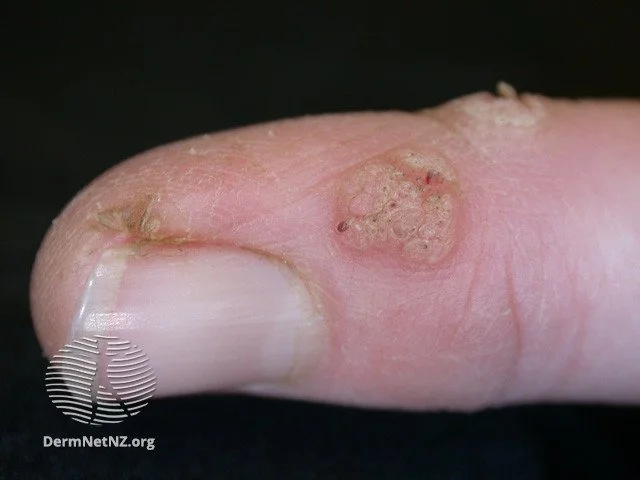
Warts (Verruca): Causes, Symptoms, and Treatments
Warts are commonly seen as scaly rough bumps on easily exposed surfaces. Sometimes one can see the black “seeds” which are actually where the blood vessels are feeding the wart.
Credit: DermNet NZ
What are warts?
Warts are common skin growths that typically appear as small, rough, and hard bumps, matching the skin's color. While they frequently appear on hands and feet, they can develop anywhere on the body. Several wart types exist, most of which are harmless and painless. However, warts on the feet can cause discomfort. While they often disappear naturally over months or years, many opt for treatments due to their persistence or cosmetic concerns. On average if warts are not treated they last for about 2-3 years.
What causes warts?
The human papillomavirus (HPV) is the culprit behind warts. Over 130 known HPV types exist, with specific strains prompting the skin cells to multiply rapidly and form warts. Strains like types 2, 3, 4, 27, 29, and 57 are particularly associated with warts. Transmission occurs through direct contact, including self-inoculation from scratching or picking. It's noteworthy that warts might emerge up to a year after HPV exposure. Immunosuppressed individuals, such as those with HIV, organ transplant recipients, or those on immunosuppressive drugs, face a heightened risk.
What are the symptoms of warts?
Warts manifest as thickened, rough, and hard skin growths, often showcasing a central black dot, which is dried blood. Various types of warts, differentiated by their appearance and location, include:
Common warts: Found mainly on fingers and toes with a raised, rough surface
Flat warts: Often appearing on the face, neck, hands, wrists, and knees, they are smooth, small, flat, and can be numerous
Filiform warts: Resembling thin projections, primarily seen on the face, eyelids, and lips
Periungual warts: Cauliflower-like clusters found under nails
Plantar warts: Occurring on foot soles' pressure points, they can be flat or lump-like and sometimes painful
Genital warts: Develop on the genital area (addressed separately)
How do I treat warts?
Warts might resolve without intervention, but some might linger or cause discomfort. Several treatment options are available:
Medication Treatment:
Podophyllotoxin solution or cream
Oral zinc
Oral cimetidine
Procedural Treatment:
Curettage or excision using scissors or scalpel
Immunotherapy injections (like Candida antigen)
How do I prevent warts?
Complete wart prevention remains elusive. The virus is very contagious and if you develop immunity to one strain you can still get other strains. Still, regular disinfection of frequently-touched surfaces is crucial, given HPV's resilience. The HPV vaccine, designed primarily for genital warts, might offer some protection against certain wart-causing strains, but research is ongoing.
If you are seeking professional advice or treatment for warts, consider reaching out to a dermatologist for expert care and personalized treatment options.
Flat warts can sometimes be mistaken for other types of skin lesions. They tend to be easier to treat with topical medications.
Credit: DermNet NZ
Plantar warts can be very difficult to treat due to the thickness of the skin and the sweatiness of the skin in this area.
Credit: DermNet NZ



